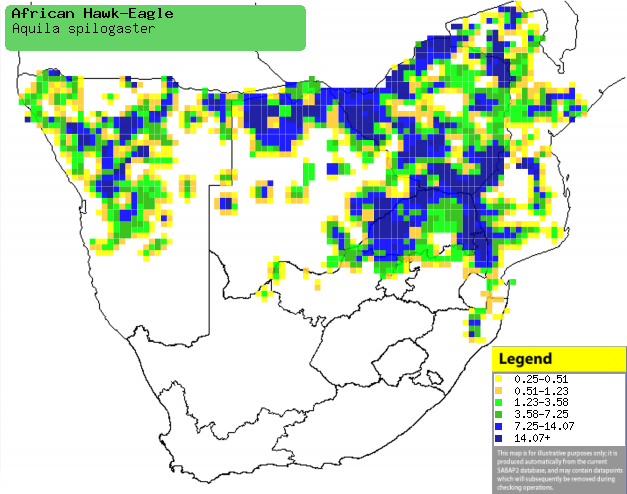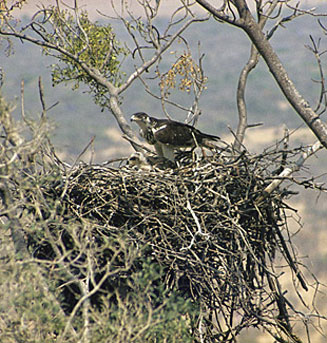|
Aquila spilogaster (African
hawk-eagle)
[= Hieraaetus spilogaster]
Grootjagarend [Afrikaans]; Ekangakodi (also applied to some
of the other eagles) [Kwangali]; Gondo (generic name for eagle) [Shona];
Ghama (generic term for eagle) [Tsonga]; Ntsu, Ntswi (generic terms for
eagles) [Tswana]; Afrikaanse havikarend [Dutch]; Aigle fascié [French];
Habichtsadler [German]; Águia-dominó [Portuguese]
Life
> Eukaryotes >
Opisthokonta
> Metazoa (animals) >
Bilateria >
Deuterostomia > Chordata >
Craniata > Vertebrata (vertebrates) > Gnathostomata (jawed
vertebrates) > Teleostomi (teleost fish) > Osteichthyes (bony fish) > Class:
Sarcopterygii (lobe-finned
fish) > Stegocephalia (terrestrial
vertebrates) > Tetrapoda
(four-legged vertebrates) > Reptiliomorpha > Amniota >
Reptilia (reptiles) >
Romeriida > Diapsida > Archosauromorpha > Archosauria >
Dinosauria
(dinosaurs) > Saurischia > Theropoda (bipedal predatory dinosaurs) >
Coelurosauria > Maniraptora > Aves
(birds) > Order: Falconiformes
> Family: Accipitridae
> Genus: Aquila
Distribution and habitat
Occupies much of sub-Saharan Africa, excluding the lowland
forest of the DRC and West Africa. In southern Africa it is locally fairly
common in northern and central Namibia, Botswana (excluding the arid Kalahari),
Zimbabwe, Mozambique and north-eastern South Africa. It generally prefers
woodland and savanna, largely absent from high altitudes and dense forest.
|
 |
|
Distribution of African hawk-eagle in southern Africa,
based on statistical smoothing of the records from first SA Bird Atlas
Project (©
Animal Demography unit, University of
Cape Town; smoothing by Birgit Erni and Francesca Little). Colours range
from dark blue (most common) through to yellow (least common).
See here for the latest distribution
from the SABAP2. |
Movements and migrations
Typically resident, although it may travel great
distances to escape from drought.
Food
It mainly eats birds, typically hunting from a perch from
which it intercepts its prey, using its large feet to tackle and kill animals weighing up to about 4 kg.
It often uses a perch overlooking a water hole, then waits for birds to come and
drink. Two hawk-eagles may hunt cooperatively; one bird flushes prey which the
other strikes, then they both feed on the carcass. The following food items have been recorded
in its diet:
- Vertebrates
- birds
- mammals
- reptiles
- carrion
Breeding
- Monogamous solitary nester, performing a courtship display in which the
breeding pair soar together while calling to each other.
- The nest (see image below) is built by both sexes, consisting of a
large platform of sticks and twigs, lined with green leaves. It is typically
placed just below the canopy of a tall tree, especially a Knob thorn (Acacia
nigrescens), about 6-19 metres above ground. It may use an
electricity pylon, cliff face or the nest of another bird, such as
Martial eagle.
 |
|
|
African hawk-eagle at its nest, Naboomspruit,
South Africa. [photo Warwick Tarboton ©] |
|
- Egg-laying season is from April-August, peaking from June-July.
- It lays 1-2 eggs, which are mainly incubated by the female for about
42-44 days, while the male regularly provides her and the chicks with food.
- The chicks are brooded closely by the female for the first week; she continues to stay close to the nest for another
three weeks, then joins the male on hunting trips to provide for the young. The
chicks
leave the nest at about 73 days old, becoming fully independent roughly
three months later.
Threats
Not threatened globally, but Near-threatened in South
Africa, as it is rare in the country. The causes of it's small population
include destruction and degradation
of woodland, and persecution for its habit of killing homing pigeons and other
domestic birds.
References
-
Hockey PAR, Dean WRJ and Ryan PG 2005. Roberts
- Birds of southern Africa, VIIth ed. The Trustees of the John Voelcker
Bird Book Fund, Cape Town.
|
